NXP Laboratories UK JN5142M0 JN5142-001-M00 IEEE802.15.4 Wireless Module User Manual JN DS JN5142 x01 Myy
NXP Laboratories UK Ltd JN5142-001-M00 IEEE802.15.4 Wireless Module JN DS JN5142 x01 Myy
Contents
- 1. Datasheet
- 2. User Datasheet
- 3. Antenna Datasheet
User Datasheet
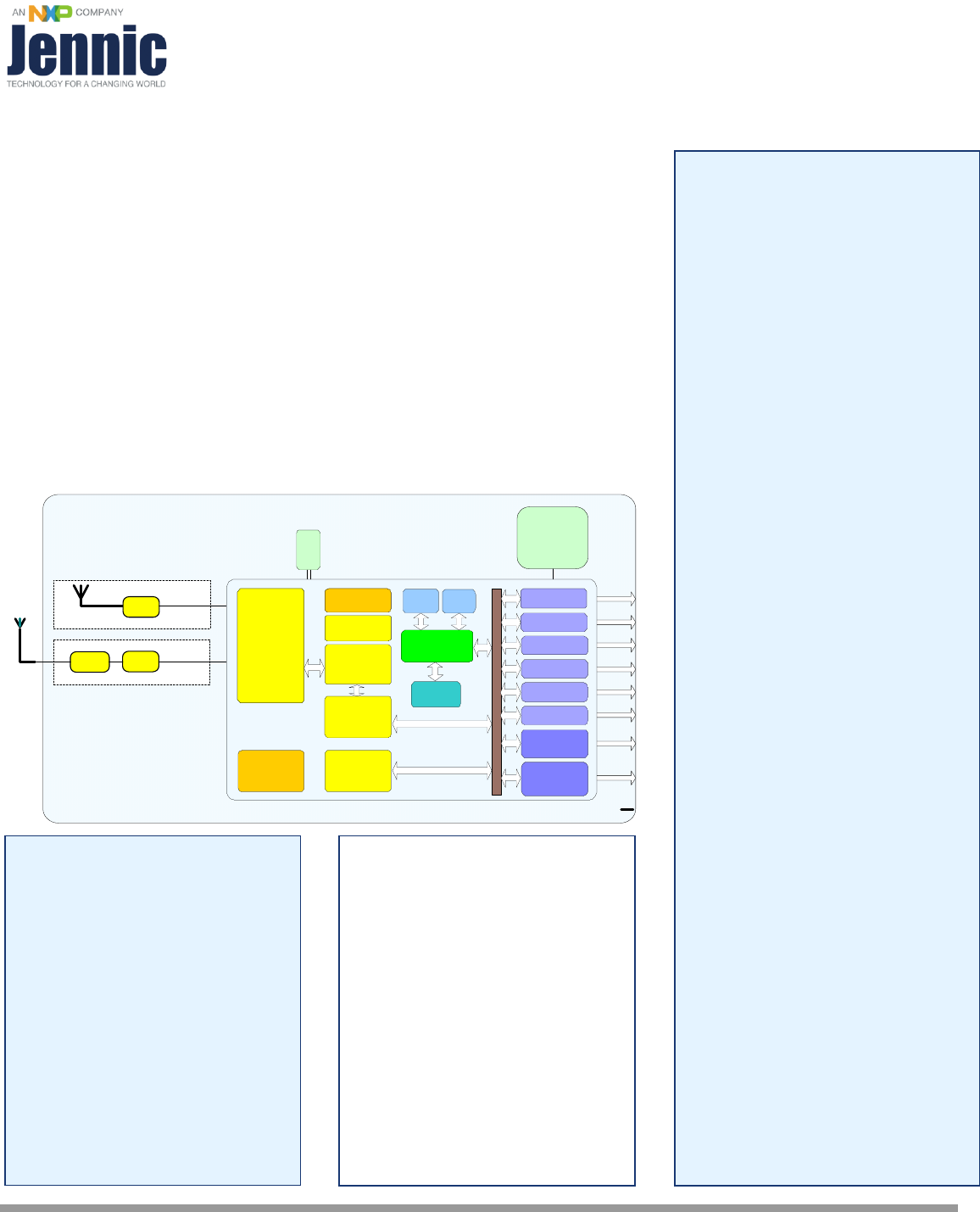
Data Sheet: JN5142-x01-Myy
JenNet-IP,RF4CE and IEEE802.15.4 Module
JN-DS-JN5142-x01-Myy 1v0 © NXP Laboratories UK 2012
Features: Module
2.4GHz IEEE802.15.4, JenNet-IP
and RF4CE compatible
Sleep current (with active sleep
timer) 0.73µA
JN5142-x01-M00/03
up to 1km range (Ext antenna)
M00: integral antenna 18x32mm
M03: uFl connector 18x30mm
o TX power +2.5dBm
o Receiver sensitivity –95dBm
o TX current 15mA
o RX current 17.5mA
o 2.3-3.6V operation
Features: Microcontroller
32-bit RISC CPU, 1-32MHz clock
speed
Low power operation
Variable instruction width for high
coding efficiency
Multi-stage instruction pipeline
128KB ROM and 32KB RAM for
bootloaded program code
Master/Slave I2C interface.
3xPWM and Application
timer/counter
UART
SPI port with 3 selects
Supply Voltage Monitor with 8
programmable thresholds
4-input 8-bit ADC
Comparator
Battery and temperature sensors
Watchdog timer and Power-on-
Reset (with brown-out) circuit
Up to 18 DIO
Industrial temp (-40°C to +125°C)
6x6mm 40-lead Punched QFN
Lead-free and RoHS compliant
Overview
The JN5142-x01-Myy family is a range of ultra low power, high performance surface
mount modules targeted at JenNet-IP and RF4CE networking applications, enabling
users to realise products with minimum time to market and at the lowest cost. They
remove the need for expensive and lengthy development of custom RF board
designs and test suites. The modules use NXP‟s JN5142 wireless microcontroller to
provide a comprehensive solution with large memory, high CPU and radio
performance and all RF components included. All that is required to develop and
manufacture wireless control or sensing products is to connect a power supply and
peripherals such as switches, actuators and sensors, considerably simplifying
product development.
Two module variants are available: JN5142-x01-M00 with an integrated antenna and
the JN5142-x01-M03 with antenna connector. The modules can implement
networking stacks such as JenNet-IP and RF4CE, as well as customer applications.
Module Block Diagram
128kB Serial Flash
Memory
Power
Matching
uFl
Connector
Integrated
Antenna
External
Antenna
M00 Option
M03 Option
32-bit
RISC CPU Timer
UART
4-Chan 8-bit ADC
Battery &
Temp sensors
,
2-Wire Serial
(Master)
SPI
128-bit AES
Encryption
Accelerator
2.4GHz
Radio
2.4GHz
Radio
ROM
128KB
Power
Management
XTAL
O-QPSK
Modem
29-byte
OTP eFuse
2-Wire Serial
(Slave)
Sleep Counter
Watchdog
Timer
Watchdog
Timer
Voltage Supply
Monitor
RAM
32KB
IEEE802.15.4
MAC
Accelerator
Matching
Benefits
Single chip optimized for simple
applications
Very low current solution for
long battery life – over 10 yrs
Highly featured 32-bit RISC
CPU for high performance and
low power
System BOM is low in
component count and cost
FCC part 15.247 rules, IC
Canada RSS 210e and ETSI EN
300-328 v 1.7 compliant
Applications
Robust and secure low power
wireless applications using
RF4CE
Remote Control
Toys and gaming peripherals
Active RFID tags
Point-to-point or star networks
using IEEE802.15.4
Energy harvesting, for example
self powered light switch

ii JN-DS-JN5142-x01-Myy 1v0 © NXP Laboratories UK 2012
Contents
1. Introduction 3
1.1. Variants 3
1.2. Regulatory Approvals 3
2. Specifications 4
3. Product Development 5
3.1. JN5142 Single Chip Wireless Microcontroller 5
4. Pin Configurations 6
4.1. Pin Assignment 7
4.2. Pin Descriptions 8
4.2.1 Power Supplies 8
4.2.2 SPI Memory Connections 8
5. Electrical Characteristics 9
5.1. Maximum Ratings 9
5.2. Operating Conditions 9
Appendix A Additional Information 10
A.1 Outline Drawing 10
A.2 Module PCB Footprint 12
A.3 Manufacturing 13
A.3.1 Reflow Profile 13
A.3.2 Soldering Paste and Cleaning 13
A.4 Ordering Information 14
A.5 Tape and Reel Information: 15
A.5.1 Tape Orientation and dimensions 15
A.5.2 Cover tape details 15
A.5.3 Leader and Trailer 16
A.5.4 Reel Dimensions: 16
A.6 Related Documents 16
A.7 Federal Communication Commission Interference Statement 17
A.7.1 Antennas approved by FCC for use with JN5142 modules 18
A.7.2 FCC End Product Labelling 18
A.8 Industry Canada Statement 18
A.8.1 Industry Canada End Product Labelling 18
A.9 European R & TTE Directive 1999/5/EC Statement 19
A.10 RoHS Compliance 19
A.11 Status Information 19
A.12 Disclaimers 20
Version Control 20
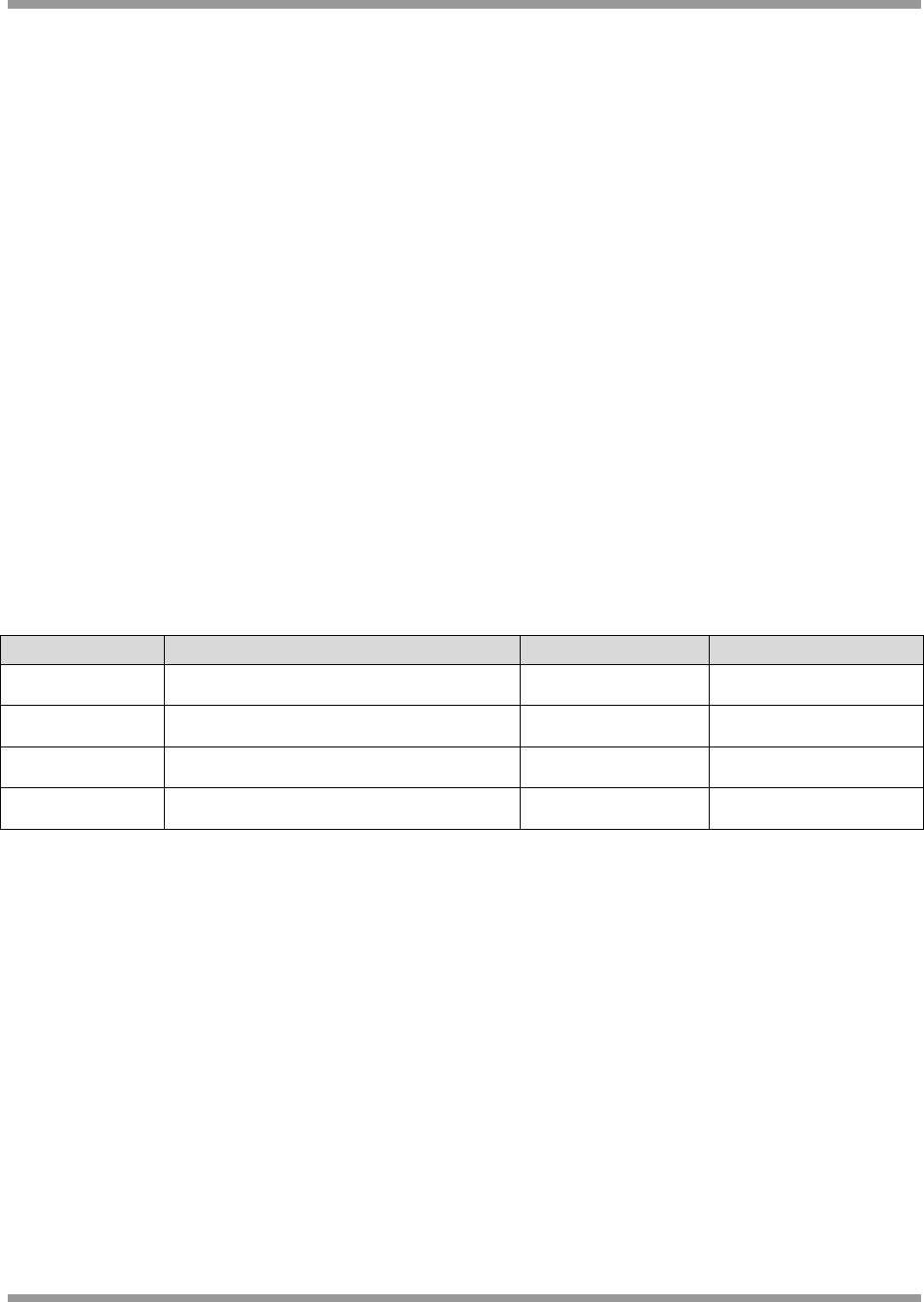
© NXP Laboratories UK 2012 JN-DS-JN5142-x01-Myy 1v0 3
1. Introduction
The JN5142-x01-Myy module family provides designers with a ready-made component that provides a fully
integrated solution for applications using the IEEE802.15.4 standard in the 2.4 - 2.5GHz ISM frequency band [1],
including RF4CE. A later version of the JN5142 will provide support for JenNet-IP “Smart Device” applications such
as lighting.
Applications that transfer data wirelessly tend to be more complex than wired ones. Wireless protocols make
stringent demands on frequencies, data formats, timing of data transfers, security and other issues. Application
development must consider the requirements of the wireless network in addition to the product functionality and user
interfaces. To minimise this complexity, NXP provides a series of software libraries and interfaces that control the
transceiver and peripherals of the JN5142. These libraries and interfaces remove the need for the developer to
understand wireless protocols and greatly simplifies the programming complexities of power modes, interrupts and
hardware functionality.
In view of the above, it is not necessary to provide the register details of the JN5142 in the datasheet.
The device includes a Wireless Transceiver, RISC CPU, on chip memory and an extensive range of peripherals.
The modules integrate all of the RF components required, removing the need to perform expensive RF design and
test. Products can be designed by simply connecting sensors and switches to the module IO pins. The modules use
an NXP single chip IEEE802.15.4 Wireless Microcontroller, allowing designers to make use of the extensive chip
development support material. Hence, this range of modules allows designers to bring wireless applications to
market in the minimum time with significantly reduced development effort and cost.
Two variants are available: JN5142-x01-M00 (standard module with integral antenna) and the JN5142-x01-M03
(standard module with uFL connector for use with external antennae). All modules have FCC modular approvals and
are compliant with EU regulations. The variants available are described below.
1.1. Variants
1.2. Regulatory Approvals
All module types have been tested against the requirements of European standard EN 300 328 v1.7.1 and a Notified
Body statement of opinion for this standard is available on request.
Additionally, all module types have received FCC “Modular Approvals”, in compliance with CFR 47 FCC part 15
regulations and in accordance to FCC Public notice DA00-1407, appendix A.7 contains details on the conditions
applying to this modular approval. The modules are approved for use with a range of different antennas; further
details of which can be found in section Appendix A.7.1. The modular approvals notice and test reports are available
on request.
In addition, all modules have Industry Canada modular approval and RSS210e Issue 7 (June 2007) certification.
Variant
Description
FCCID
Industry Canada ID
JN5142-001-M00
Standard Power, integrated antenna,
IEEE802.15.4 stack
TYOJN5142M0
IC: 7438A-CYO5142M0
JN5142-J01-M00
Standard Power, integrated antenna,
Jennet IP stack
TYOJN5142M0
IC: 7438A-CYO5142M0
JN5142-001-M03
Standard Power, uFl connector,
IEEE802.15.4 stack
TYOJN5142M3
IC: 7438A-CYO5142M3
JN5142-J01-M03
Standard Power, uFl connector, Jennet IP
stack
TYOJN5142M3
IC: 7438A-CYO5142M3

4 JN-DS-JN5142-x01-Myy 1v0 © NXP Laboratories UK 2012
2. Specifications
Most specification parameters for the modules are specified in the chip datasheet - JN-DS-JN5142 Wireless
Microcontroller Datasheet, [2]. Where there are differences, the parameters are defined here.
VDD=3.0V @ +25°C
Typical DC Characteristics
Notes
JN5142-x01-
M00/03
Deep sleep current
100nA
Sleep current
0.73uA
With active sleep timer
Radio transmit current
14.8mA
CPU in doze, radio transmitting
Radio receive current
16.5mA
CPU in doze, radio receiving
Centre frequency accuracy
+/-25ppm
Additional +/-15ppm allowance for
temperature and ageing
Typical RF Characteristics
Notes
Receive sensitivity
-95dBm
Nominal for 1% PER, as per 802.15.4 section
6.5.3.3 (Note 1)
Maximum Transmit power
+2.5dBm
Nominal (Note 1)
Maximum input signal
+10dBm
For 1% PER, measured as sensitivity
RSSI range
-95 to -10
dBm
RF Port impedance – uFl connector
50 ohm
2.4 - 2.5GHz
VSWR (max)
2:1
2.4 - 2.5GHz
Peripherals
Notes
Master SPI port
3 selects
250kHz - 16MHz
Slave SPI port
250kHz - 8MHz
UART
16550 compatible
Two-wire serial I/F (compatible with SMbus &
I2C)
Up to 400kHz
Two programmable Timer/Counters with
capture/compare facility, Tick timer
16MHz clock
Two programmable Sleep Timers
32kHz clock
Digital IO lines (multiplexed with UARTs,
timers and SPI selects)
18
Four channel Analogue-to-Digital converter
8-bit, up to 100ks/s
Programmable analogue comparator
Ultra low power mode for sleep
Internal temperature sensor and battery
monitor
The performance of all peripherals is defined in the JN-DS-JN5142 Wireless Microcontroller Datasheet [2]
Note 1: Sensitivity is defined for conducted measurements on connectorised modules. Modules with an integrated
antenna have approximately 3 dB less e.i.r.p and reciprocal receive sensitivity.

© NXP Laboratories UK 2012 JN-DS-JN5142-x01-Myy 1v0 5
3. Product Development
NXP supplies all the development tools and networking stacks needed to enable end-product development to occur
quickly and efficiently. These are all freely available from www.nxp.com/jennic. A range of evaluation/developer kits
is also available, allowing products to be quickly bread boarded. Efficient development of software applications is
enabled by the provision of a complete, unlimited, software developer kit. Together with the available libraries for the
IEEE802.15.4 MAC and the JenNet-IP and RF4CE network stacks, this package provides everything required to
develop application code and to trial it with hardware representative of the final module.
The modules can be user programmed both in development and in production using software supplied by NXP.
Access to the on-chip peripherals, MAC and network stack software is provided through specific APIs. This
information is available on the NXP/Jennic support website, together with many example applications, user guides,
reference manuals and application notes.
3.1. JN5142 Single Chip Wireless Microcontroller
The JN5142-x01-Myy series is constructed around the JN5142-x01 single chip wireless microcontroller, which
includes the radio system, a 32-bit RISC CPU, ROM and RAM memory and a range of analogue and digital
peripherals.
The chip is described fully in JN-DS-JN5142 Wireless Microcontroller Datasheet [2].
The module also includes a 1Mbit serial flash memory, which holds the application code that is loaded into the
JN5142 during the boot sequence and provides static data storage, required by the application.
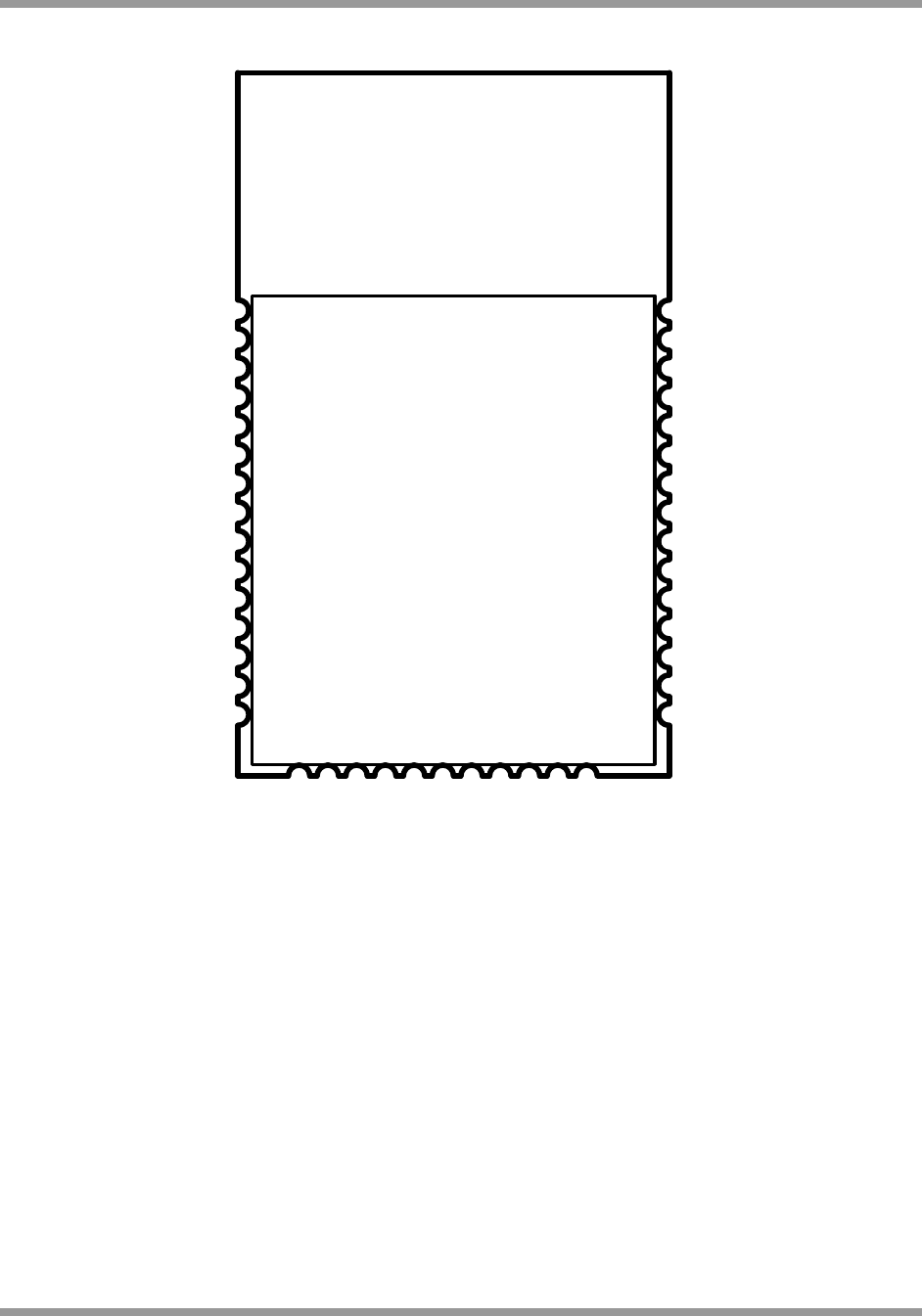
6 JN-DS-JN5142-x01-Myy 1v0 © NXP Laboratories UK 2012
4. Pin Configurations
1
2
3
4
16
ADC1
NC
NC
NC
NC
SPICLK
SPIMISO
SPIMOSI
SPISSZ
DIO0
DIO1
DIO2
SPISSM
SPISWP
DIO3
DIO4
DIO5
DIO6
DIO7
DIO8
DIO9
DIO10
DIO11
VDD
GND
VSSA
NC
ADC2
NC
NC
NC
NC
DIO17
DIO16
DIO15
RESETN
DIO14
DIO13
DIO12
5
6
7
8
9
10
11
12
13
14
15
17 18 19 20 21 22 23 24 25 26
41
40
39
38
37
36
35
34
33
32
31
30
29
28
27
NC
NC
Figure 1: Pin Configuration (top view)
Note that the same basic pin configuration applies for all module designs.

© NXP Laboratories UK 2012 JN-DS-JN5142-x01-Myy 1v0 7
Pin Assignment
Pin
No
Pin Functions
Signal
Type
Description
Primary
Alternate Functions
1
ADC1
3.3V
Analogue to Digital Input
2
NC
3
NC
4
NC
5
NC
6
SPICLK
CMOS
SPI Clock Output
7
SPIMISO
CMOS
SPI Master In Slave Out Input
8
SPIMOSI
CMOS
SPI Master Out Slave In Output
9
SPISSZ
CMSO
SPI Select From Module – SS0
Output
10
DIO0
SPISEL1
ADC3
CMOS
DIO0 or SPI Slave Select Output 1
or ADC input 3
11
DIO1
SPISEL2
ADC4
PC0
CMOS
DIO1, SPI Slave Select Output 2,
ADC input 4 or Pulse Counter0
Input
12
DIO2
TIM0CK_GT
RFRX
CMOS
DIO2, Timer0 Clock/Gate Input or
Radio Receive Control Output
13
SPISSM
CMOS
SPI Select to FLASH (Input)
14
SPISWP
CMOS
FLASH Write Protect (Input)
15
DIO3
TIM0CAP
RFTX
CMOS
DIO3, Timer0 Capture Input or
Radio Transmit Control Output
16
DIO4
CTS0
JTAG_TCK
TIM0OUT
CMOS
DIO4, UART 0 Clear To Send
Input, JTAG CLK or Timer0 PWM
Output
17
DIO5
RTS0
JTAG_TMS
PWM1
PC1
CMOS
DIO5, UART 0 Request To Send
Output, JTAG Mode Select,
PWM1 Output or Pulse Counter 1
Input
18
DIO6
TXD0
JTAG_TDO
PWM2
CMOS
DIO6, UART 0 Transmit Data
Output, JTAG Data Output or
PWM2 Output
19
DIO7
RXD0
JTAG_TDI
PWM3
CMOS
DIO7, UART 0 Receive Data
Input, JTAG Data Input or PWM 3
Output
20
DIO8
TIM0CK_GT
PC1
CMOS
DIO8, Timer0 Clock/Gate Input or
Pulse Counter1 Input
21
DIO9
TIM0CAP
32KXTALIN
CMOS
DIO9, Timer0 Capture Input or
32K External Crystal Input
22
DIO10
TIM0OUT
32KXTALOUT
CMOS
DIO10, Timer0 PWM Output or
32K External Crystal Output
23
DIO11
PWM1
CMOS
DIO11 or PWM1 Output
24
VDD
3.3V
Supply Voltage
25
GND
0V
Digital Ground
26
VSSA
0V
Analogue Ground
27
DIO12
PWM2
CTS0
JTAG_TCK
AD0
CMOS
DIO12, PWM2 Output, UART 0
Clear To Send Input, JTAG CLK or
Antenna Diversity Odd
28
DIO13
PWM3
RTS0
JTAG_TMS
ADE
CMOS
DIO13, PWM3 Output, UART 0
Request To Send Output, JTAG
Mode Select or Antenna Diversity
Even
29
RESETN
CMOS
Reset input

8 JN-DS-JN5142-x01-Myy 1v0 © NXP Laboratories UK 2012
30
DIO14
SIF_CLK
TXD0
JTAG_TDO
SPISEL1
CMOS
DIO14, Serial Interface Clock,
UART 0 Transmit Data Output,
JTAG Data Output or SPI Slave
Select Output 1
31
DIO15
SIF_D
RXD0
JTAG_TDI
SPISEL2
CMOS
DIO15, Serial Interface Data,
UART 0 Receive Data Input, JTAG
Data Input or SPI Slave Select
Output 2
32
DIO16
COMP1P
SIF_CLK
CMOS
DIO16, Comparator Positive Input
or Serial Interface clock
33
DIO17
COMP1M
SIF_D
CMOS
DIO17, Comparator Negative Input
or Serial Interface Data
34
NC
35
NC
36
NC
37
NC
38
NC
39
NC
40
ADC2
VREF
3.3V
Analogue peripheral reference
voltage or ADC input 2
41
NC
4.2. Pin Descriptions
All pins behave as described in the JN-DS-JN5142 Wireless Microcontroller Datasheet [2], with the exception of the
following:
4.2.1 Power Supplies
A single power supply pin, VDD is provided. Separate analogue (VSSA) and digital (GND) grounds are provided.
These should be connected together at the module pins.
4.2.2 SPI Memory Connections
SPISWP is a write protect pin for the serial flash memory. This should be held low to inhibit writes to the flash device.
SPISSZ is connected to SPI Slave Select 0 on the JN5142.
SPISSM is connected to the Slave Select pin on the memory.
This configuration allows the flash memory device to be programmed using an external SPI programmer if required.
For programming in this mode, the JN5142 should be held in reset by taking RESETN low. Two suggested flash
1Mbit memory devices that may be used in the module are, the Micron M25P10A and the Winbond W25X10B.
The memory can also be programmed over the UART by using the flash programmer software provided by NXP. This
is available as part of the Software Developer kit and libraries available from www.nxp.com/jennic. To enter this
programming mode, SPIMISO (pin 7) should be held low whilst the chip is reset. Once programming has finished, the
chip should be reset, when it will execute the new code downloaded.
For normal operation of the module and programming over the UART, SPISSZ should be connected to
SPISSM.

© NXP Laboratories UK 2012 JN-DS-JN5142-x01-Myy 1v0 9
5. Electrical Characteristics
In most cases, the Electrical Characteristics are the same for both module and chip. They are described in detail in
the chip datasheet. Where there are differences, they are detailed below.
5.1. Maximum Ratings
Exceeding these conditions will result in damage to the device.
Parameter
Min
Max
Device supply voltage VDD
-0.3V
3.6V
Voltage on analogue pins ADC1-2
-0.3V
VDD + 0.3V
Voltage on 5v tolerant digital pins DIO0-DIO8 &
DIO11-17, RESETN
-0.3V
Lower of (VDD + 2V) and
5.5V
Voltage on 3v tolerant digital pins DIO9, DIO10,
SPISSM, SPISWP, SPICLK, SPIMOSI, SPIMISO,
SPISSZ
-0.3V
VDD + 0.3V
Storage temperature
-40ºC
150ºC
5.2. Operating Conditions
Supply
Min
Max
VDD
2.3V
3.6V
Ambient temperature range
-40ºC
125ºC
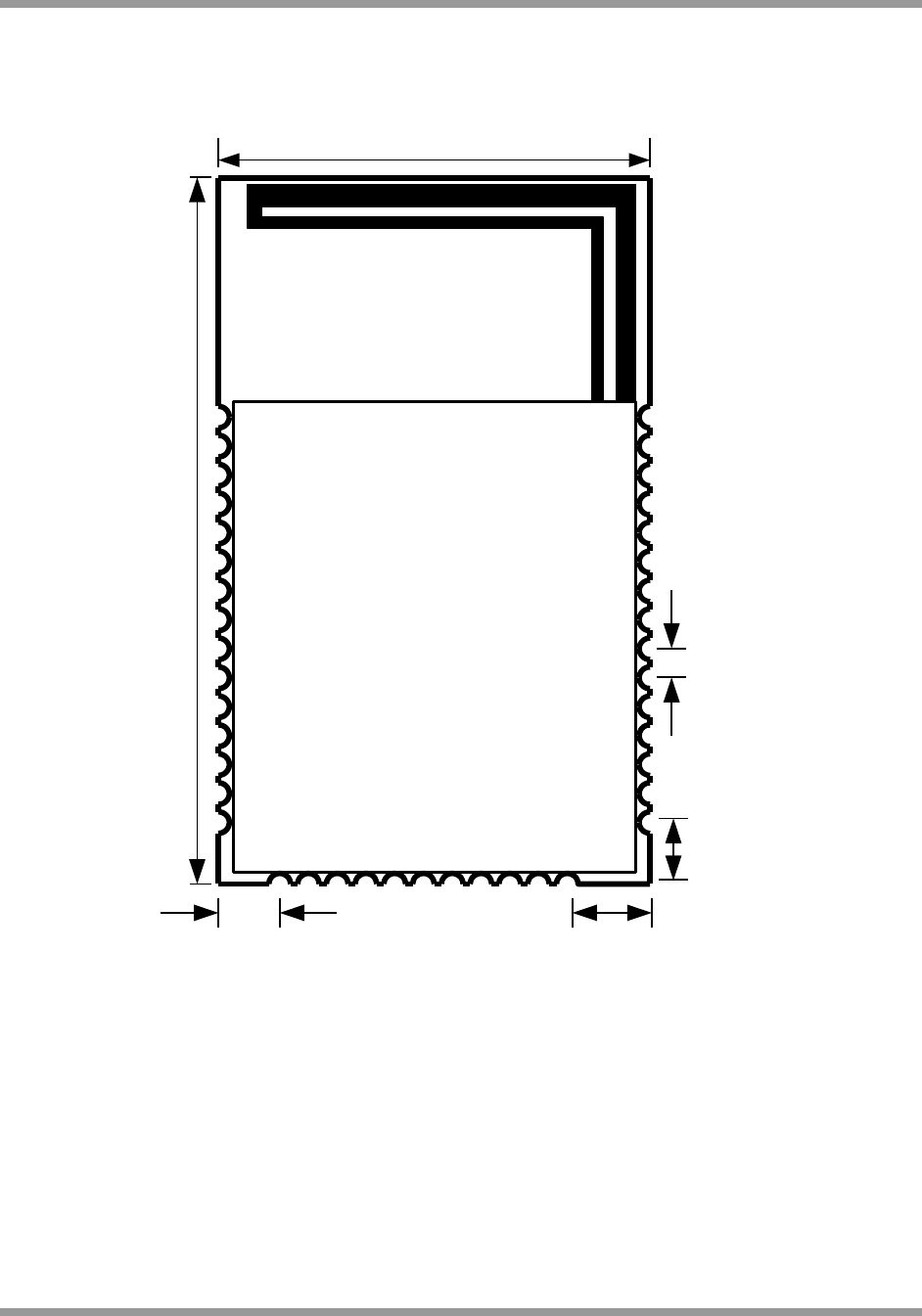
10 JN-DS-JN5142-x01-Myy 1v0 © NXP Laboratories UK 2012
Appendix A Additional Information
A.1 Outline Drawing
32.2mm
18mm
2.76
mm
2.54
mm
2.54
mm
1.27
mm
Thickness: 3.5mm
Figure 2 JN5142-x01-M00 Outline Drawing
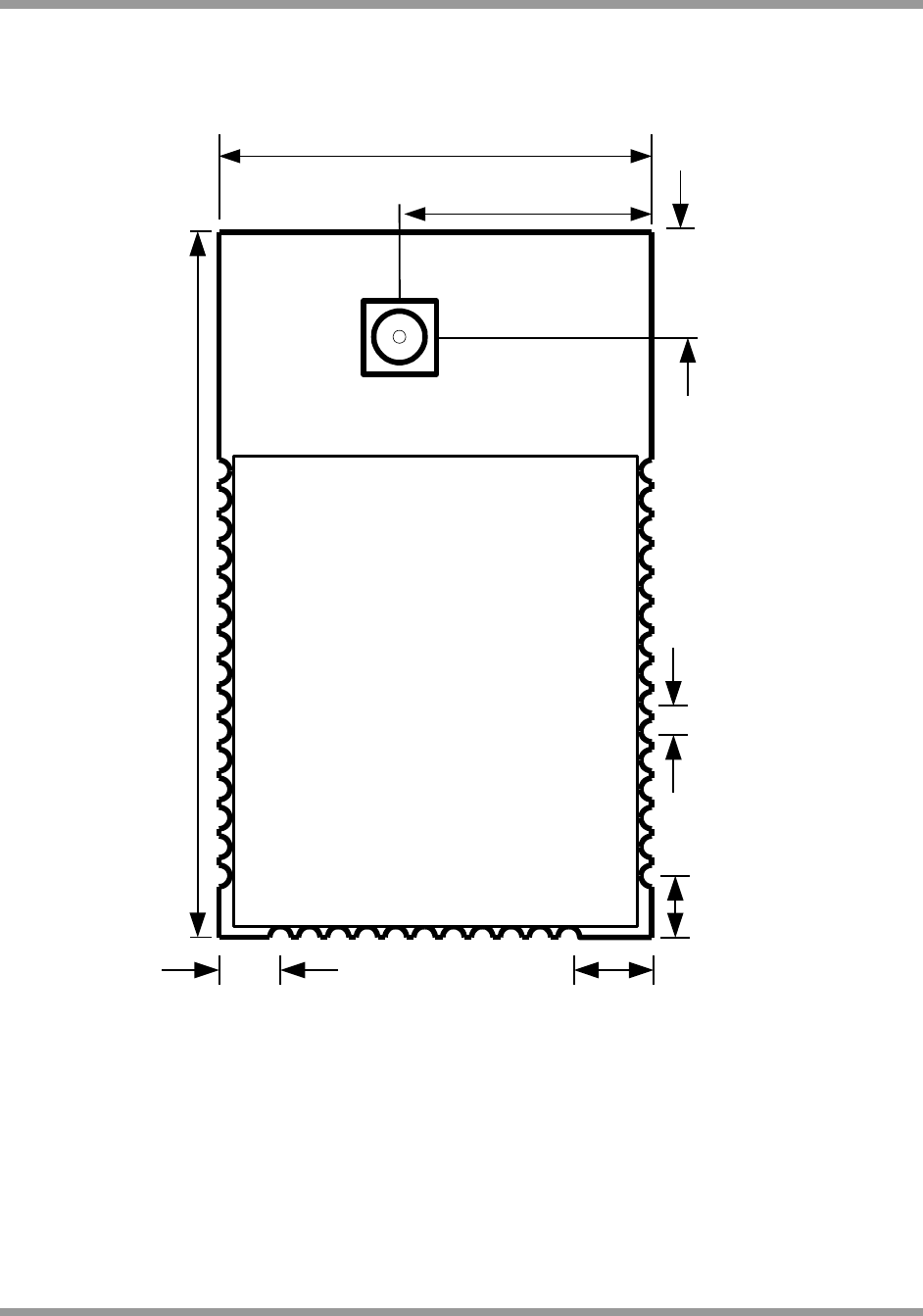
© NXP Laboratories UK 2012 JN-DS-JN5142-x01-Myy 1v0 11
30mm
18mm
2.76
mm
2.54
mm
2.54
mm
6.58
mm
9.76mm
1.27
mm
Thickness: 3.5mm
Figure 3 JN5142-x01-M03 Outline Drawing
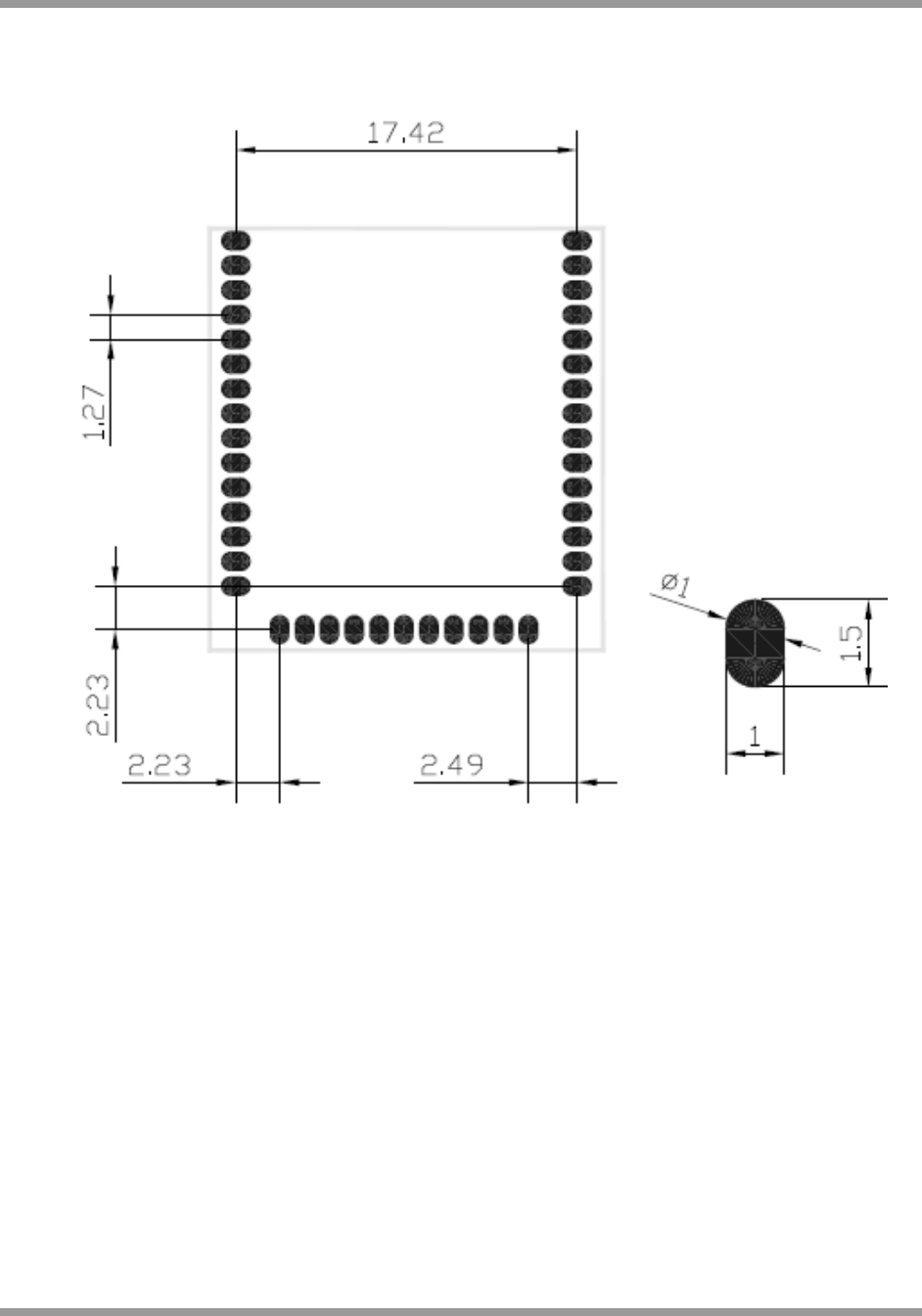
12 JN-DS-JN5142-x01-Myy 1v0 © NXP Laboratories UK 2012
A.2 Module PCB Footprint
All dimensions are in mm.
Note: All modules have the same footprint.
Figure 4 Module PCB footprint
RF note for –M00 modules with integral antenna: No components, ground plane or tracks on any layer of the
mother board should be placed within 20mm of the 3 free sides of the antenna. Tracks etc may be placed
adjacent to the can, but should not extend past the can towards the antenna end of the module for 20mm
from the antenna.
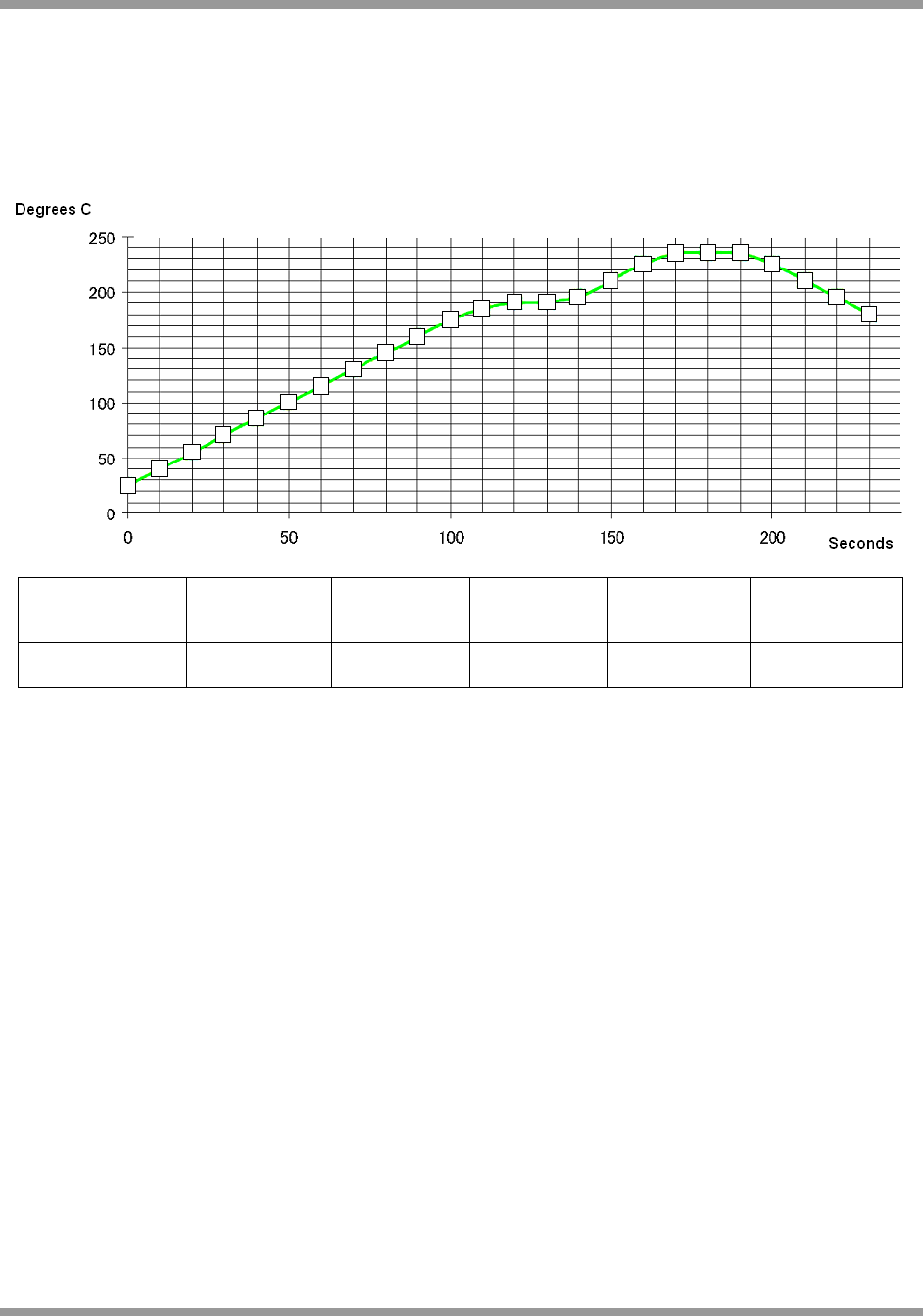
© NXP Laboratories UK 2012 JN-DS-JN5142-x01-Myy 1v0 13
A.3 Manufacturing
A.3.1 Reflow Profile
For reflow soldering, it is recommended to follow the reflow profile in figure 6 as a guide, as well as the paste
manufacturers guidelines on peak flow temperature, soak times, time above liquidus and ramp rates.
Figure 5: Recommended solder reflow profile
A.3.2 Soldering Paste and Cleaning
NXP would not recommend use of a solder paste that requires the module and pcb assembly to be cleaned (rinsed in
water) for the following reasons:
Solder flux residues and water can be trapped by the pcb, can or components and result in short circuits.
The module label could be damaged or removed.
NXP recommends use of a 'no clean' solder paste for all its module products.
Temperature
25~160 ºC
160~190 ºC
> 220º C
230~Pk.
Pk. Temp
(235ºC)
Target Time (s)
90~130
30~60
20~50
10~15
150~270
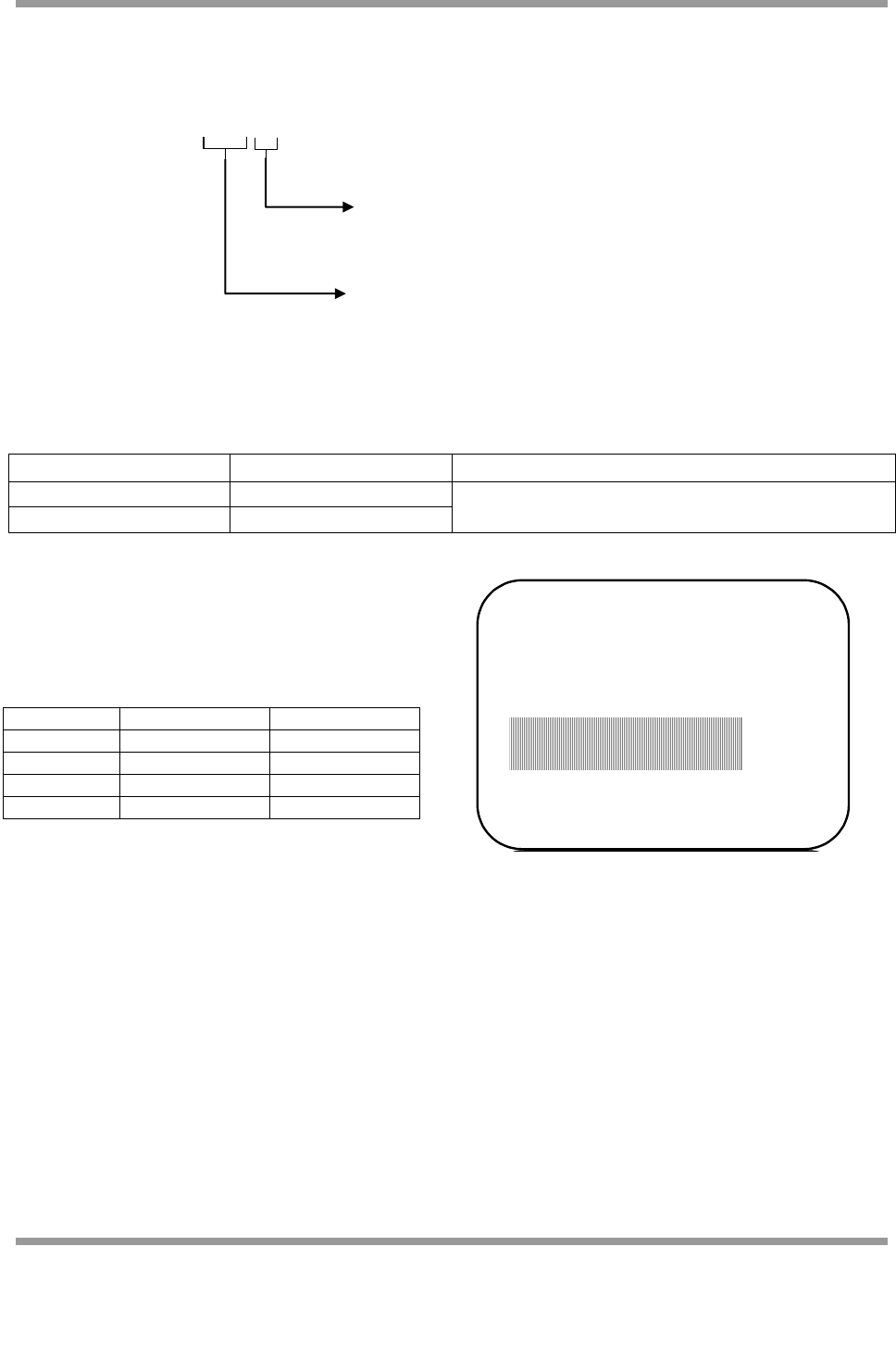
14 JN-DS-JN5142-x01-Myy 1v0 © NXP Laboratories UK 2012
A.4 Ordering Information
Ordering Code Format:
Where this Data Sheet is denoted as “Advanced” or “Preliminary”, devices will be either Engineering Samples or
Prototypes. Devices of this status have an Rx suffix after the module type to identify qualification status during these
product phases - for example, JN5142-X01-M00R1T.
Part Number
Ordering Code
Description
JN5142-x01-M00T
JN5142-x01-M/00T
JN5142 module, variant as detailed above
JN5142-x01-M03T
JN5142-x01-M/03T
Shipping
T Tape Mounted 500-piece reel
JN5142 - x01 – M / Y1Y2 Y3
Module Type
00 Standard Power, Integral antenna
03 Standard Power, uFl connector
Label line 1: IC ID Number
Label line 2: FCC ID Number
Label line 3: Part Number
Label line 4: Barcode Label
Label line 5: YYWWTNNNNN (see below)
Identifier
Description
Format
YY
Year
06 (example)
WW
Week
45 (example)
T
Module type
NNNNN
Serial Number
YYWWTNNNNN
IC: 7438A
CYO5142M0
FCC ID: TYOJN5142M0
M0
JN51XX
-
XXX
-
XXX NXP
Part Name
YYWWTNNNNN
FCC ID: TYOJN5139M0
Figure 6: Example module labelling for FCC approved modules
Figure 7: Example module labelling for FCC approved modules
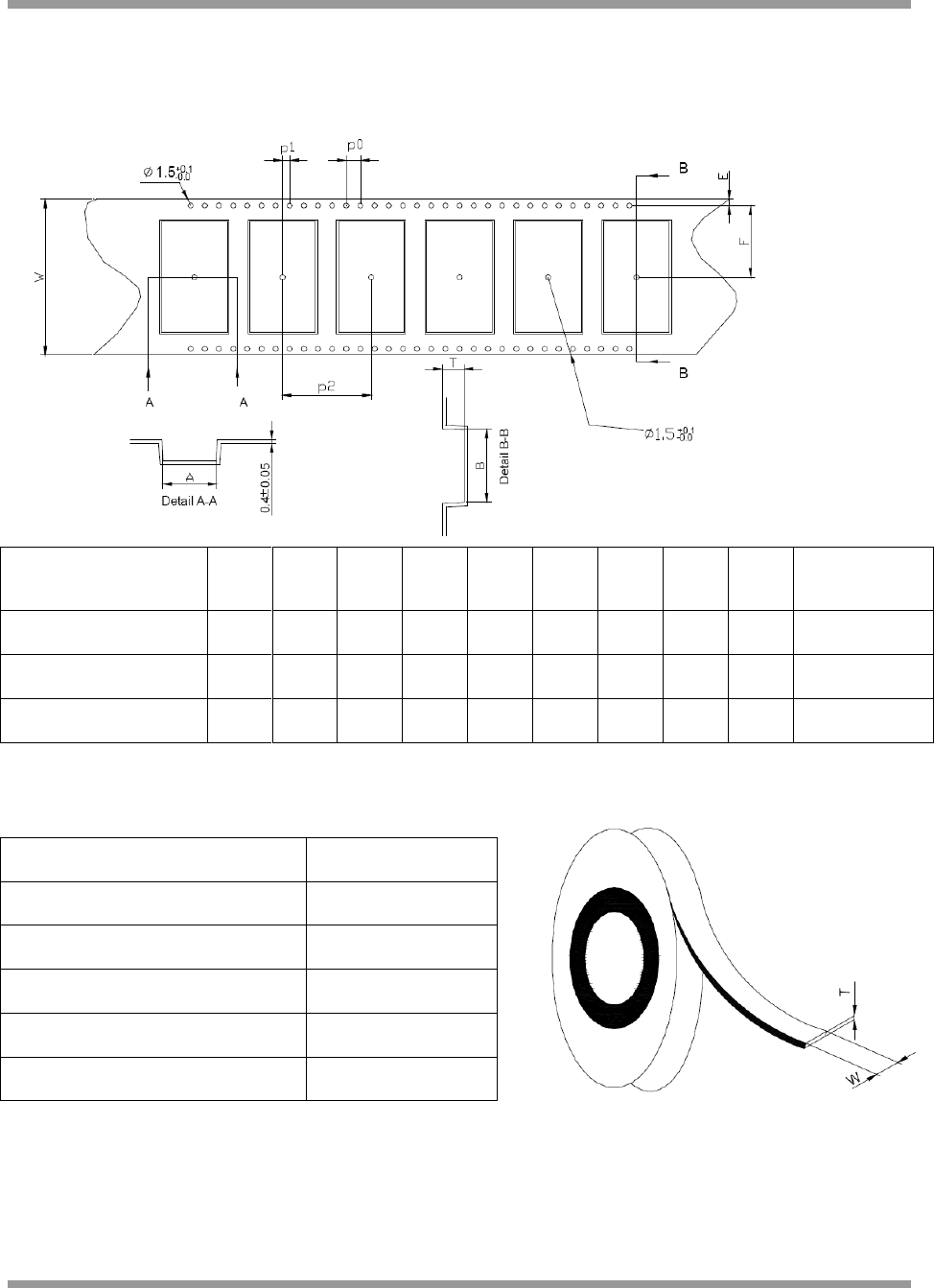
© NXP Laboratories UK 2012 JN-DS-JN5142-x01-Myy 1v0 15
A.5 Tape and Reel Information:
A.5.1 Tape Orientation and dimensions
All dimensions are in mm
Module type:
A
B
W
F
E
P0
P1
P2
T
Cover Tape
width (W)
JN5142-x01-M00
18.4
32.6
44
20.2
1.75
4.0
2.0
24.0
3.4
37.5
JN5142-x01-M03
18.4
30.4
44
20.2
1.75
4.0
2.0
24.0
3.4
37.5
Tolerance
±0.1
±0.1
±0.3
±0.1
+0.1
±0.1
±0.1
±0.1
±0.1
±0.1
A.5.2 Cover tape details
Thickness (T)
0.061mm
Surface resistivity (component side)
104 to 107 Ohms/sq
Surface resistivity (component side)
Non-conductive
Backing type:
Polyester
Adhesive type:
PSA
Sealing:
Room ambient
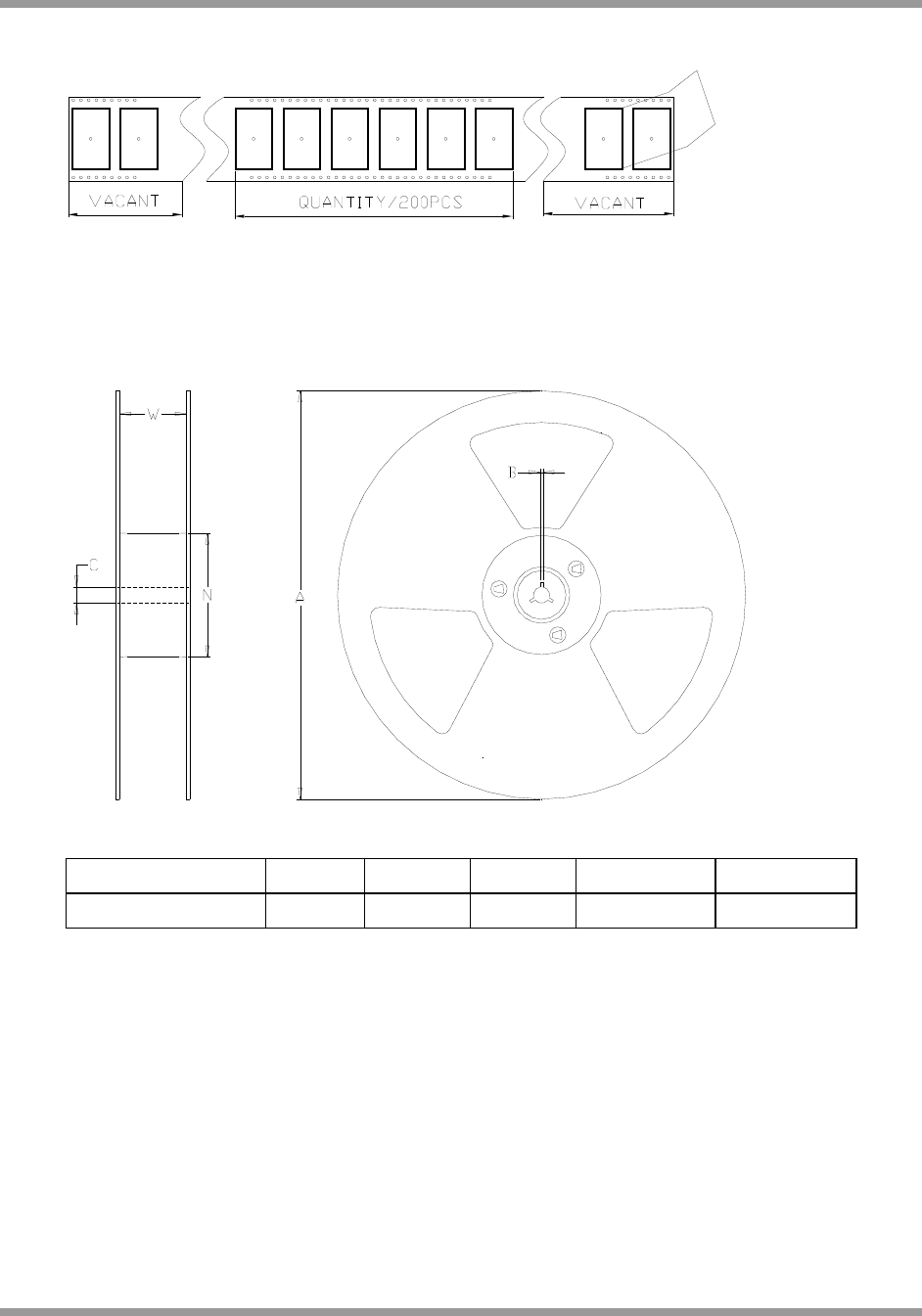
16 JN-DS-JN5142-x01-Myy 1v0 © NXP Laboratories UK 2012
A.5.3 Leader and Trailer
A.5.4 Reel Dimensions:
All dimensions are in mm.
Module type:
A
B
C
N
W (min)
JN5142-x01-M00/03
330 ±1.0
2.2±0.5
13 ±0.2
100 +0.1
44.5 ±0.3
A.6 Related Documents
[1] IEEE Std 802.15.4-2003 IEEE Standard for Information Technology – Part 15.4 Wireless Medium Access Control
(MAC) and Physical Layer (PHY) Specifications for Low-Rate Wireless Personal Area Networks (LR-WPANs)
[2] JN-DS-JN5142 Wireless Microcontroller Datasheet
300 MM300 MM

© NXP Laboratories UK 2012 JN-DS-JN5142-x01-Myy 1v0 17
A.7 Federal Communication Commission Interference Statement
This equipment has been tested and found to comply with the limits for a Class B digital device, pursuant to Part 15
of the FCC Rules. These limits are designed to provide reasonable protection against harmful interference in a
residential installation. This equipment generates, uses, and can radiate radio frequency energy and, if not installed
and used in accordance with the instructions, may cause harmful interference to radio communications. However,
there is no guarantee that interference will not occur in a particular installation. If this equipment does cause harmful
interference to radio or television reception, which can be determined by turning the equipment off and on, the user is
encouraged to try to correct the interference by one of the following measures:
- Reorient or relocate the receiving antenna.
- Increase the separation between the equipment and receiver.
- Connect the equipment into an outlet on a circuit different from that to which the receiver is connected.
- Consult the dealer or an experienced radio/TV technician for help.
This device complies with Part 15 of the FCC Rules. Operation is subject to the following two conditions: (1) This
device may not cause harmful interference, and (2) this device must accept any interference received, including
interference that may cause undesired operation.
FCC Caution: Any changes or modifications not expressly approved by the party responsible for compliance could
void the user's authority to operate this equipment.
WARNING!
FCC Radiation Exposure Statement:
This portable equipment with its antenna complies with FCC‟s RF radiation exposure limits set forth for an
uncontrolled environment. To maintain compliance follow the instructions below;
1. This transmitter must not be co-located or operating in conjunction with any other antenna or transmitter.
2. Avoid direct contact to the antenna, or keep it to a minimum while using this equipment.
This transmitter module is authorized to be used in other devices only by OEM integrators under the
following condition:
The transmitter module must not be co-located with any other antenna or transmitter.
As long as the above condition is met, further transmitter testing will not be required. However, the OEM integrator is
still responsible for testing their end product for any additional compliance requirements required with this module
installed (for example, digital device emissions, PC peripheral requirements, etc.).
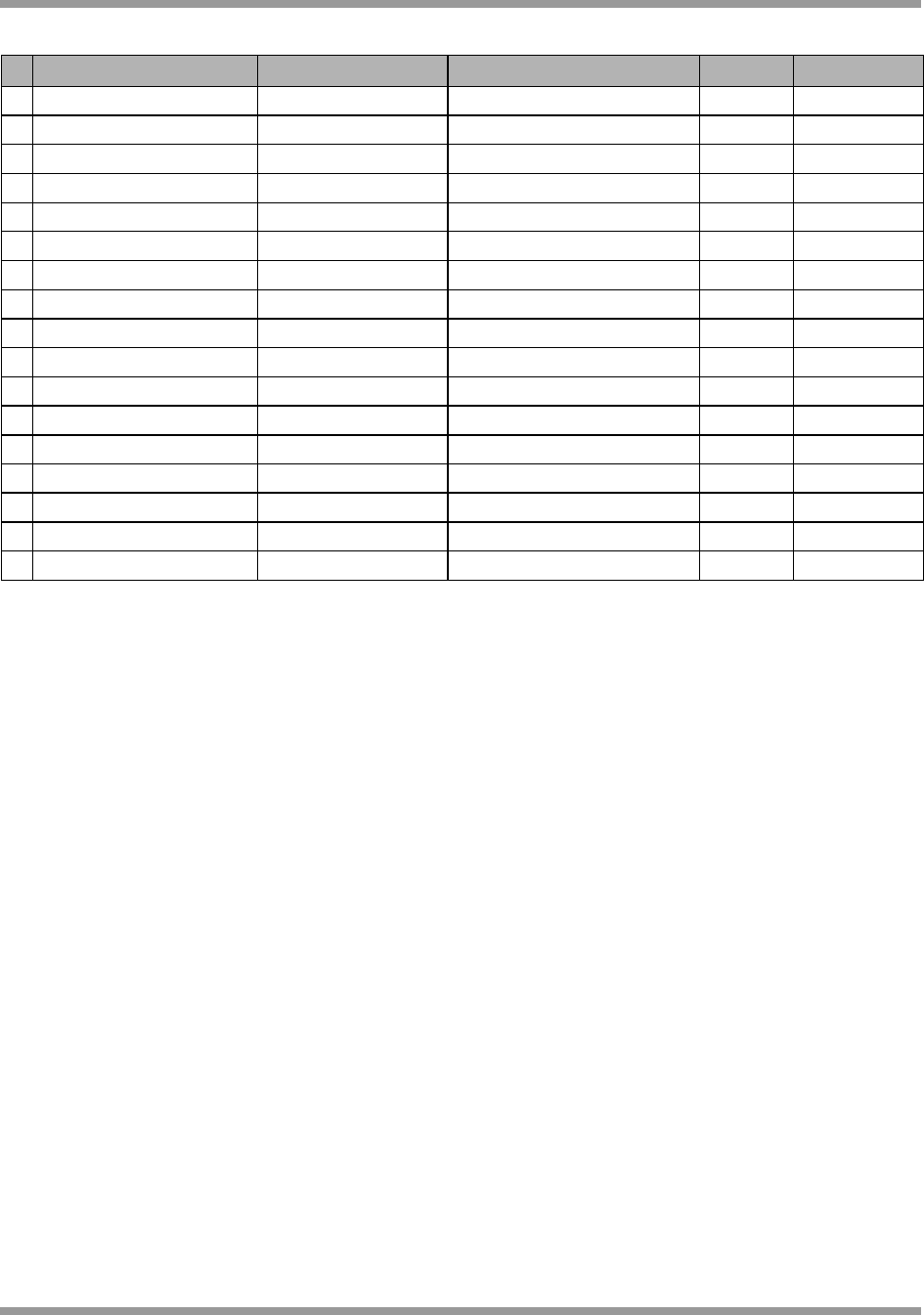
18 JN-DS-JN5142-x01-Myy 1v0 © NXP Laboratories UK 2012
A.7.1 Antennas approved by FCC for use with JN5142 modules
Brand
Model Number
Description
Gain (dBi)
Connector type
1
Antenna Factor
ANT-2.4-CW-RCT-RP
Vertical - knuckle antenna
2.2
RP-SMA
2
Antennova
2010B6090-01
Vertical - knuckle antenna
2.2
RP-SMA
3
Hyperlink Technology
HG2402RD-RSF
Vertical - knuckle antenna
2.2
RP-SMA
4
Aveslink Technology, Inc
E-0005-AC
Vertical- flying lead
2
RP-SMA
5
Aveslink Technology, Inc
E-2411-GC
Vertical - swivel
2
RP-SMA
6
Aveslink Technology, Inc
E-2410-CA
Vertical - bulkhead- flying lead
2
uFL
7
Aveslink Technology, Inc
E-2410-GC
Vertical - swivel
2
RP-SMA
8
Aveslink Technology, Inc
E-2820-CA
Vertical - bulkhead- flying lead
2
uFL
9
Aveslink Technology, Inc
E-2820-GC
Vertical - swivel
2
RP-SMA
10
Aveslink Technology, Inc
E-0903-AX
Embedded - nickel silver strip
2
None
11
Aveslink Technology, Inc
E-0904-AX
Embedded - nickel silver strip
2
None
12
Embedded Antenna Design
FBKR35068-RS-KR
Vertical - knuckle antenna
2
RP-SMA
13
Nearson
S131CL-L-PX-2450S
Vertical - knuckle-flying lead
2
uFL
14
Laird Technologies
WRR2400-IP04
Vertical - knuckle-flying lead
1.5
uFL
15
Laird Technologies
WRR2400-RPSMA
Vertical - knuckle-flying lead
1.3
RP-SMA
16
Aveslink Technology, Inc
E-6170-DA
Vertical - right angle
1
uFL
17
Laird Technologies
WCR2400-SMRP
Vertical - knuckle antenna
1
RP-SMA
These antennae or versions with alternative connectors may be used to meet European regulations.
This device has been designed to operate with the antennas listed above, and having a maximum gain of 2.2 dBi.
Antennas not included in this list or having a gain greater than 2.2 dBi are strictly prohibited for use with this device.
The required antenna impedance is 50 ohms.
A.7.2 FCC End Product Labelling
The final „end product‟ should be labelled in a visible area with the following:
“Contains TX FCC ID: TYOJN5142M0 or TYOJN5142M3” to reflect the version of the module being used inside the
product.
A.8 Industry Canada Statement
To reduce potential radio interference to other users, the antenna type and its gain should be so chosen that the
equivalent isotropically radiated power (e.i.r.p.) is not more than that permitted for successful communication.
These modules have been designed to operate with antennas having a maximum gain of 2.2 dBi. Antennas having a
gain greater than 2.2 dBi are strictly prohibited for use with this device. The required antenna impedance is 50 ohms.
As long as the above condition is met, further transmitter testing will not be required. However, the OEM integrator is
still responsible for testing their end-product for any additional compliance requirements required with this module
installed (for example, digital device emissions, PC peripheral requirements, etc).
A.8.1 Industry Canada End Product Labelling
For Industry Canada purposes the following should be used.
“Contains Industry Canada ID IC: 7438A-CYO5142M0 or IC: 7438A-CYO5142M3” to reflect the version of the module
being used inside the product.
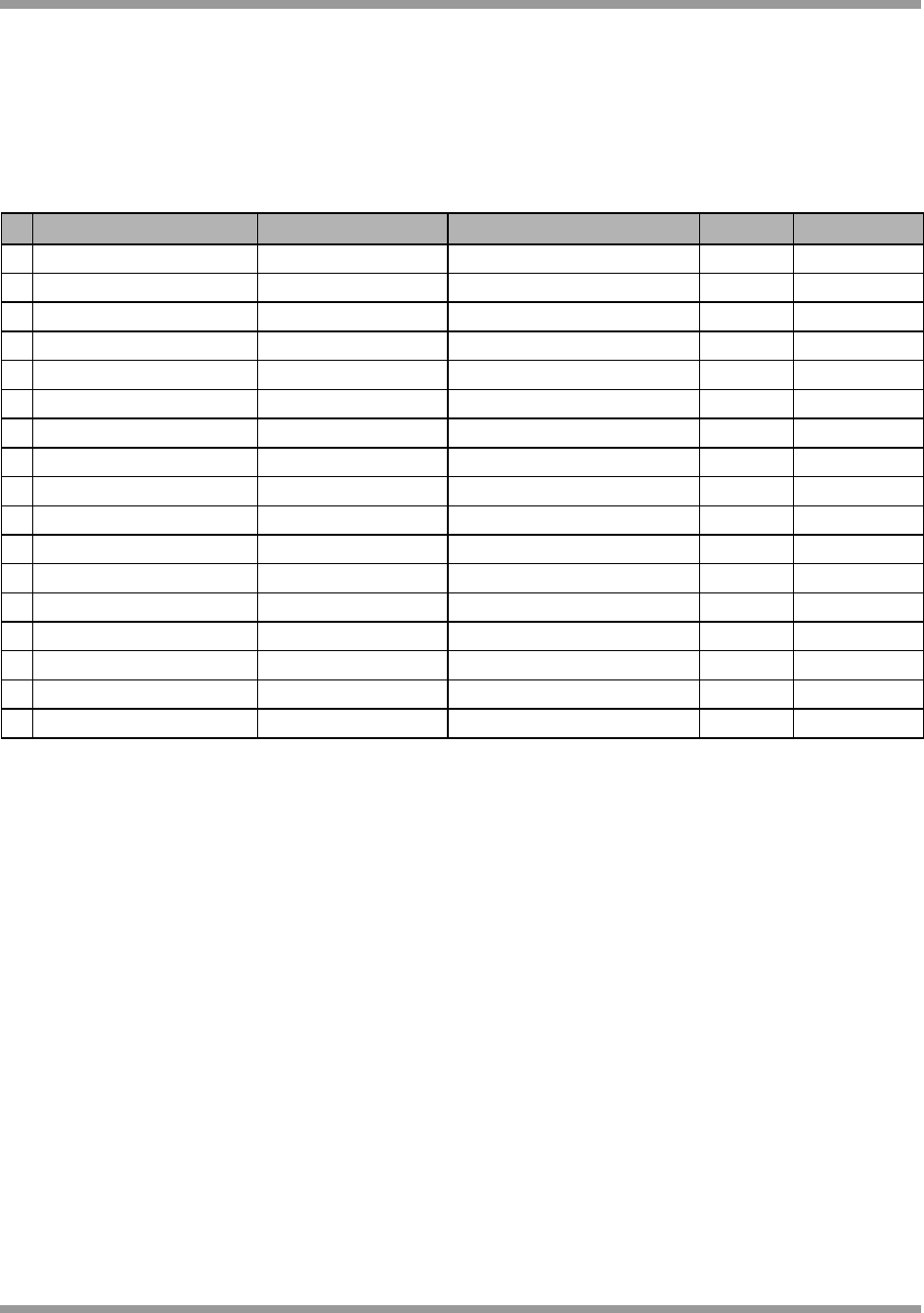
© NXP Laboratories UK 2012 JN-DS-JN5142-x01-Myy 1v0 19
A.9 European R & TTE Directive 1999/5/EC Statement
All modules listed in this datasheet are compliant with ETSI EN 300 328V1.7.1 (2006/05) and are subject to a Notified
Body Opinion.
The modules are approved for use with the antennas listed in the following table.
Brand
Model Number
Description
Gain (dBi)
Connector type
1
Antenna Factor
ANT-2.4-CW-RCT-RP
Vertical - knuckle antenna
2.2
RP-SMA
2
Antennova
2010B6090-01
Vertical - knuckle antenna
2.2
RP-SMA
3
Hyperlink Technology
HG2402RD-RSF
Vertical - knuckle antenna
2.2
RP-SMA
4
Aveslink Technology, Inc
E-0005-AC
Vertical- flying lead
2
RP-SMA
5
Aveslink Technology, Inc
E-2411-GC
Vertical - swivel
2
RP-SMA
6
Aveslink Technology, Inc
E-2410-CA
Vertical - bulkhead- flying lead
2
uFL
7
Aveslink Technology, Inc
E-2410-GC
Vertical - swivel
2
RP-SMA
8
Aveslink Technology, Inc
E-2820-CA
Vertical - bulkhead- flying lead
2
uFL
9
Aveslink Technology, Inc
E-2820-GC
Vertical - swivel
2
RP-SMA
10
Aveslink Technology, Inc
E-0903-AX
Embedded - nickel silver strip
2
None
11
Aveslink Technology, Inc
E-0904-AX
Embedded - nickel silver strip
2
None
12
Embedded Antenna Design
FBKR35068-RS-KR
Vertical - knuckle antenna
2
RP-SMA
13
Nearson
S131CL-L-PX-2450S
Vertical - knuckle-flying lead
2
uFL
14
Laird Technologies
WRR2400-IP04
Vertical - knuckle-flying lead
1.5
uFL
15
Laird Technologies
WRR2400-RPSMA
Vertical - knuckle-flying lead
1.3
RP-SMA
16
Aveslink Technology, Inc
E-6170-DA
Vertical - right angle
1
uFL
17
Laird Technologies
WCR2400-SMRP
Vertical - knuckle antenna
1
RP-SMA
A.10 RoHS Compliance
JN5142-x01-Myy devices meet the requirements of Directive 2002/95/EC of the European Parliament and of the
Council on the Restriction of Hazardous Substance (RoHS).
The JN5142-x01-M00 and M03 modules meet the requirements of Chinese RoHS requirements SJ/T11363-2006.
Full data can be found at www.nxp.com/jennic.
A.11 Status Information
The status of this Data Sheet is Preliminary.
NXP products progress according to the following format:
Advanced
The Data Sheet shows the specification of a product in planning or in development.
The functionality and electrical performance specifications are target values and may be used as a guide to the final
specification.
NXP reserves the right to make changes to the product specification at anytime without notice.

20 JN-DS-JN5142-x01-Myy 1v0 © NXP Laboratories UK 2012
Preliminary
The Data Sheet shows the specification of a product that is commercially available, but is not yet fully qualified.
The functionality of the product is final. The electrical performance specifications are target values and may be used
as a guide to the final specification. Modules are identified with an Rx suffix, for example JN5142-x01-M00R2.
NXP reserves the right to make changes to the product specification at anytime without notice.
Production
This is the production Data Sheet for the product.
All functional and electrical performance specifications, where included, including min and max values are derived
from detailed product characterization.
This Data Sheet supersedes all previous document versions.
NXP reserves the right to make changes to the product specification at anytime.
A.12 Disclaimers
The contents of this document are subject to change without notice. NXP reserves the right to make changes,
without notice, in the products, including circuits and/or software, described or contained therein. Information
contained in this document regarding device applications and the like is intended through suggestion only and may
be superseded by updates. It is your responsibility to ensure that your application meets with your specifications.
NXP warrants performance of its hardware products to the specifications applicable at the time of sale in accordance
with NXP‟s standard warranty. Testing and other quality control techniques are used to the extent NXP deems
necessary to support this warranty. Except where mandatory by government requirements, testing of all parameters
of each product is not necessarily performed.
NXP assumes no responsibility or liability for the use of any of these products, conveys no license or title under any
patent, copyright, or mask work right to these products, and makes no representations or warranties that these
products are free from patent, copyright, or mask work infringement, unless otherwise specified.
NXP products are not intended for use in life support systems, appliances or systems where malfunction of these
products can reasonably be expected to result in personal injury, death or severe property or environmental damage.
NXP customers using or selling these products for use in such applications do so at their own risk and agree to fully
indemnify NXP for any damages resulting from such use.
All products are sold subject to NXP's terms and conditions of sale supplied at the time of order acknowledgment.
All trademarks are the property of their respective owners.
Version Control
Version
Notes
1.0
1st Issue of Preliminary Datasheet
NXP Laboratories UK Ltd
Furnival Street
Sheffield
S1 4QT
United Kingdom
Tel: +44 (0)114 281 2655
Fax: +44 (0) 114 281 2951
For the contact details of your local NXP office or distributor, refer to the NXP web site:
www.nxp.com/jennic